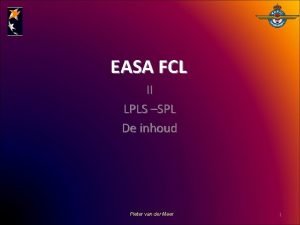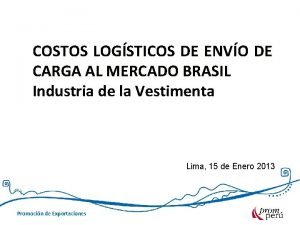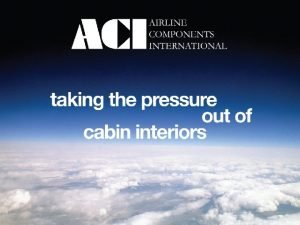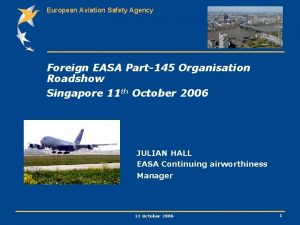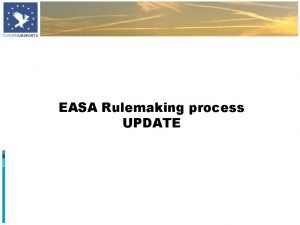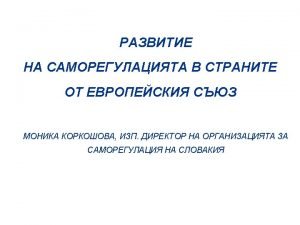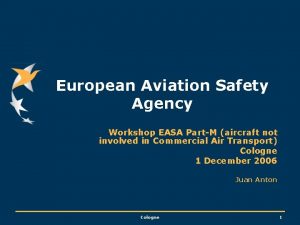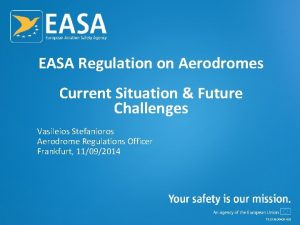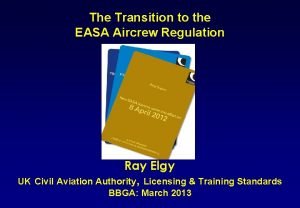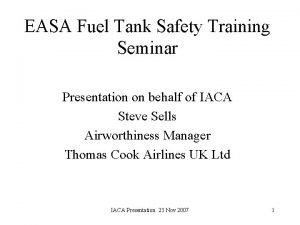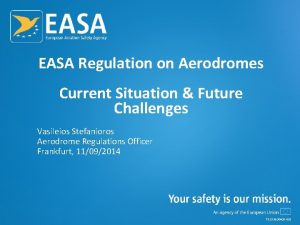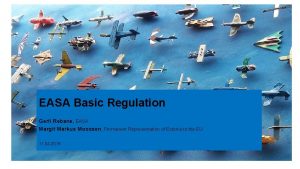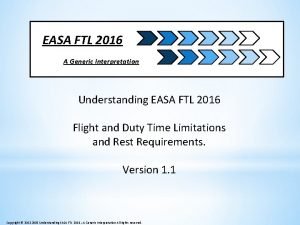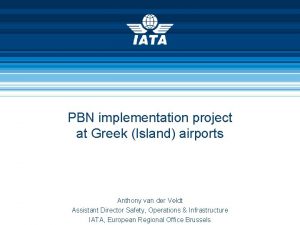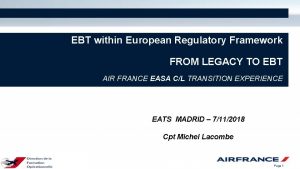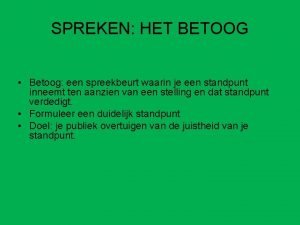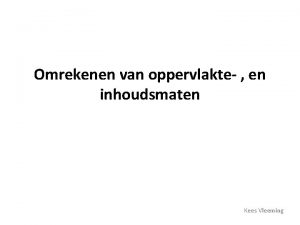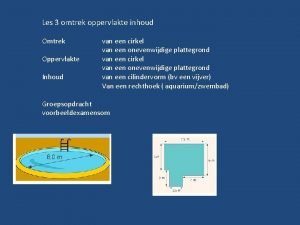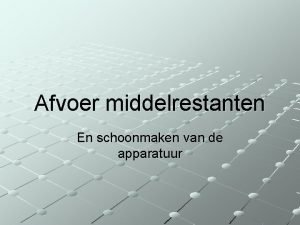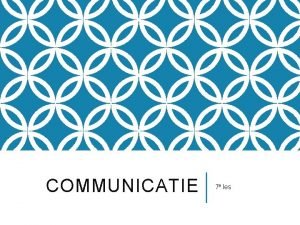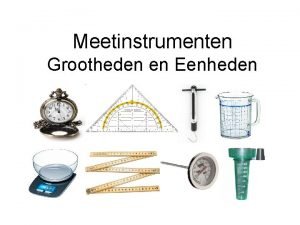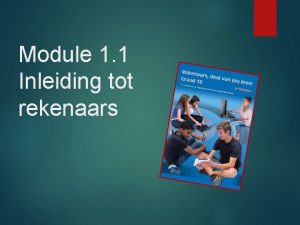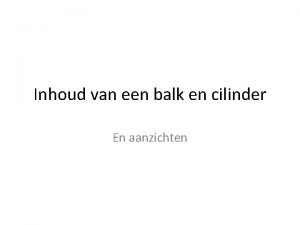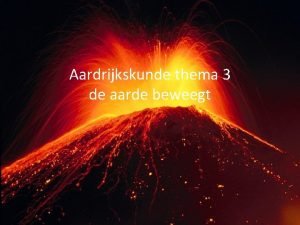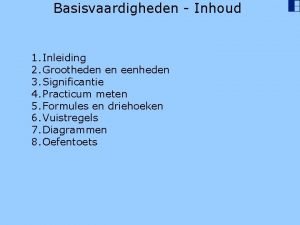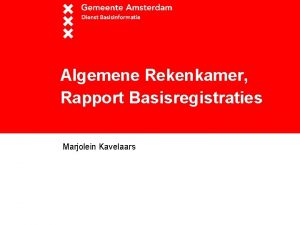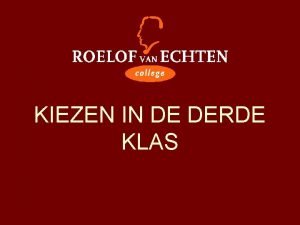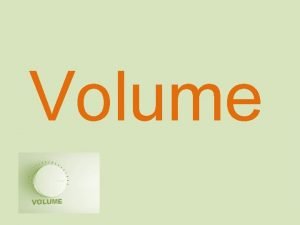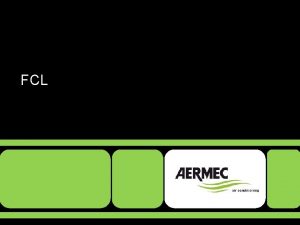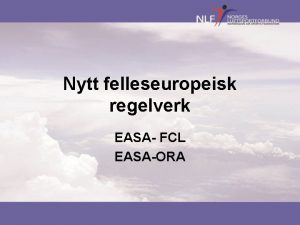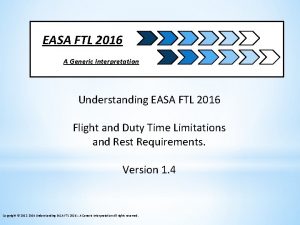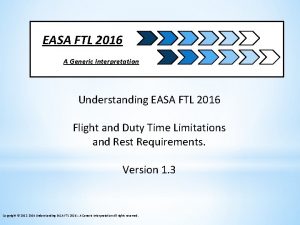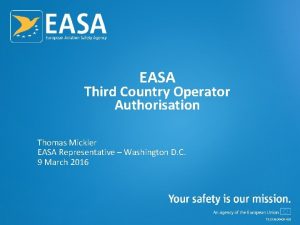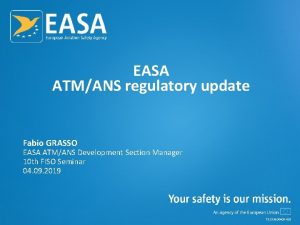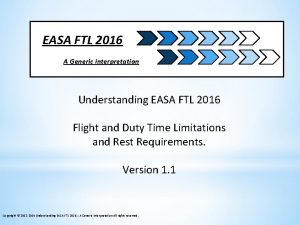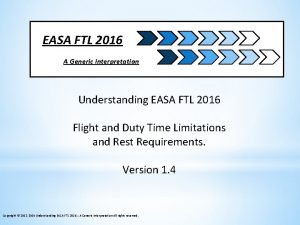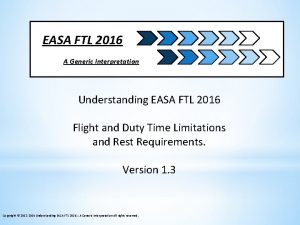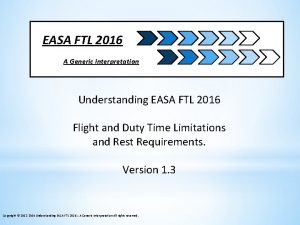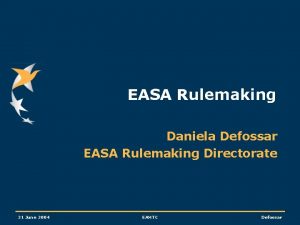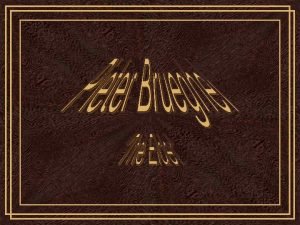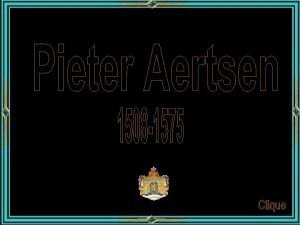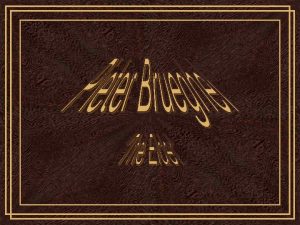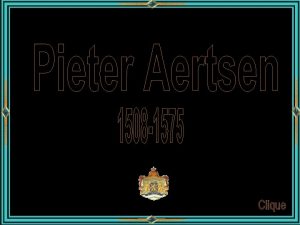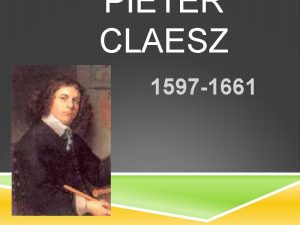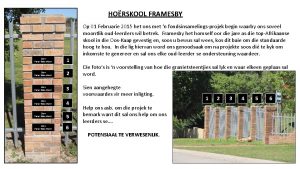EASA FCL II LPLS SPL De inhoud Pieter




































- Slides: 36

EASA FCL II LPLS –SPL De inhoud Pieter van der Meer 1

Zweefvliegopleiding volgens Europees model • Theoretische kennis voor LPL S en SPL • Praktijk opleiding LPL S en SPL • De consequenties voor de Nederlandse zweefvlieger 2

Theorie 1. Voor de opleiding naar het LPL S of SPL 2. Voor uitbreiding naar TMG 3. Kunstvliegen (Aerobatics) 4. Sleepvliegers 5. Instructeurs 3

Theoretische kennis voor LPL S en SPL BASIS KENNIS LPL + ZWEEFVLIEGEN = LPLS /SPL Ø AIR LAW AND ATC PROCEDURES Ø Ø HUMAN PERFORMANCE Ø Ø METEOROLOGIE Ø FLIGHT PERFORMANCE AND PLANNING SAILPLANE Ø COMMUNICATIONS Ø AIRCRAFT GENERAL KNOWLEDGE – AIRFRAME AND SYSTEMS, EMERGENCY EQUIPMENT Ø NAVIGATION SAILPLANE PRINCIPLES OF FLIGHT SAILPLANE OPERATIONAL PROCEDURES SAILPLANE 4

AIR LAW AND ATC PROCEDURES • • • • 1. 1. INTERNATIONAL LAW: CONVENTIONS, AGREEMENTS AND ORGANISATIONS 1. 2. AIRWORTHINESS OF AIRCRAFT 1. 3. AIRCRAFT NATIONALITY AND REGISTRATION MARKS 1. 4. PERSONNEL LICENSING 1. 5. RULES OF THE AIR 1. 6. PROCEDURES FOR AIR NAVIGATION – AIRCRAFT OPERATIONS 1. 7. AIR TRAFFIC REGULATIONS – AIRSPACE STRUCTURE <<<? 1. 8. AIR TRAFFIC SERVICES AND AIR TRAFFIC MANAGEMENT 1. 9. AIR TRAFFIC REGULATIONS – AIRSPACE STRUCTURE <<<? 1. 10. AERONAUTICAL INFORMATION SERVICE 1. 11. AERODROMES, EXTERNAL TAKE OFF SITES 1. 12. SEARCH AND RESCUE 1. 13. SECURITY 1. 14. ACCIDENT REPORTING 1. 15. NATIONAL LAW Theoretische kennis voor LPL-S en SPL 5

HUMAN PERFORMANCE • • • 2. 1. HUMAN FACTORS: BASIC CONCEPTS 2. 2. BASIC AVIATION PHYSIOLOGY AND HEALTH MAINTENANCE 2. 3. BASIC AVIATION PSYCHOLOGY Theoretische kennis voor LPL-S en SPL 6

METEOROLOGIE • • • 3. 1 THE ATMOSPHERE 3. 2. WIND 3. 3. THERMODYNAMICS 3. 4. CLOUDS AND FOG 3. 5. PRECIPITATION 3. 6. AIR MASSES AND FRONTS 3. 7. PRESSURE SYSTEMS 3. 8. CLIMATOLOGY 3. 9. FLIGHT HAZARDS 3. 10. METEOROLOGICAL INFORMATION 7

COMMUNICATIONS • • 4. 1. VFR COMMUNICATIONS (RT !) 4. 2. DEFINITIONS 4. 3. GENERAL OPERATING PROCEDURES 4. 4. RELEVANT WEATHER INFORMATION TERMS (VFR) 4. 5. ACTION REQUIRED TO BE TAKEN IN CASE OF COMMUNICATION FAILURE 4. 6. DISTRESS AND URGENCY PROCEDURES 4. 7. GENERAL PRINCIPLES OF VHF PROPAGATION AND ALLOCATION OF FREQUENCIES Theoretische kennis voor LPL-S en SPL 8

Zweefvliegen specifiek PRINCIPLES OF FLIGHT SAILPLANE • • • 5. 1. AERODYNAMICS (AIRFLOW) 5. 2. FLIGHT MECHANICS 5. 3. STABILITY 5. 4. CONTROL 5. 5. LIMITATIONS (LOAD FACTOR AND MANOEUVRES) 5. 6. STALLING AND SPINNING Theoretische kennis voor LPL-S en SPL 9

OPERATIONAL PROCEDURES SAILPLANE • • • 6. 1. GENERAL REQUIREMENTS 6. 2. LAUNCH METHODS 6. 3. SOARING TECHNIQUES 6. 4. CIRCUITS AND LANDING 6. 5. OUTLANDING 6. 6. SPECIAL OPERATIONAL PROCEDURES AND HAZARDS Theoretische kennis voor LPL-S en SPL 10

FLIGHT PERFORMANCE AND PLANNING SAILPLANE • • • 7. 1. VERIFYING MASS AND BALANCE 7. 2. SPEED POLAR OF SAILPLANES / CRUISING SPEED 7. 3. FLIGHT PLANNING AND TASK SETTING 7. 4. ICAO FLIGHT PLAN (ATS Flight Plan) 7. 5. FLIGHT MONITORING AND INFLIGHT REPLANNING Theoretische kennis voor LPL-S en SPL 11

AIRCRAFT GENERAL KNOWLEDGE – AIRFRAME AND SYSTEMS, EMERGENCY EQUIPMENT • • 8. 1. AIRFRAME 8. 2. SYSTEM DESIGN, LOADS, STRESSES 8. 3. LANDING GEAR, WHEELS, TYRES, BRAKES 8. 4. MASS AND BALANCE 8. 5. FLIGHT CONTROLS 8. 6. INSTRUMENTS 8. 7. MANUALS AND DOCU MENTS 8. 8. AIRWOTHINESS, MAINTENANCE Theoretische kennis voor LPL-S en SPL 12

NAVIGATION SAILPLANE • • • 9. 1. BASICS OF NAVIGATION 9. 2. MAGNETISM AND COMPASSES 9. 3. CHARTS 9. 4. DEAD RECKONING NAVIGATION (DR) 9. 5. INFLIGHT NAVIGATION 9. 6. GLOBAL NAVIGATION SATELLITE SYSTEMS Theoretische kennis voor LPL-S en SPL 13

Wat is echt nieuw • • • Airlaw HF Meteo Communications Principle of flight Operational Procedures Flight performance and planning Aircraft general knowledge. . Navigation 50 % 100% Is nu ingevuld 100% Hebben we al 0% !!!! RT +++ 80% Aero+ 70% Start methoden enz. 10% 90% (incl. instrumenten) 30% Kaartlezen 14

Extra theorie voor TMG • Principles of flight (extra for TMG) • Operational Procedures for touring motor gliders • Flight performance and planning (Extra for TMG) • Aircraft general knowledge (Extra for TMG) • Navigation (extra for TMG) 15

Extra theorie voor Aerobatics • Human factors and body limitation • Technical subjects • Limitations applicable to the specific aircraft category • Aerobatic manoeuvres and recovery • Emergency procedures 16

Sleep vliegen (motor vlieger) • Regulations concerning towing flights • Equipment for the towing activity • Sailplane towing techniques including…. . • Flight performance of the applicable aircraft type when towing sailplanes • Look out and collision avoidance • Performance data sailplanes including…. . 17

Theorie voor Instructeurs Algemeen voor (LA)FI THE LEARNING PROCESS THE TEACHING PROCESS TRAINING PHILOSOPHIES TECHNIQUES OF APPLIED INSTRUCTION STUDENT EVALUATION AND TESTING TRAINING PROGRAMME DEVELOPMENT HUMAN PERFORMANCE AND LIMITATIONS RELEVANT TO FLIGHT INSTRUCTION • SPECIFIC HAZARDS INVOLVED IN SIMULATING SYSTEMS FAILURES AND MALFUNCTIONS IN • THE AIRCRAFT DURING FLIGHT • TRAINING ADMINISTRATION • • 18

19

Praktijkopleiding LPL S en SPL Een club moet worden geaccepteerd als een Approved Training Organisation (ATO). Zowel voor de theorie als voor de praktijkopleiding moet de club aan een aantal voorwaarden voldoen. Een leerling moet eerst een medische keuringcertificaat hebben voordat hij of zij begint met de praktijk opleiding. De syllabus voor het LPL S en het SPL moet ten minste aandacht besteden aan de volgend onderwerpen: 20

Syllabus Praktijkopleiding 1 ü pre flight operations, including verifying mass and balance, aircraft inspection and servicing. ü aerodrome and traffic pattern operations, collision avoidance precautions and procedures. ü control of the aircraft by external visual reference. ü flight at high angle of attack (critically low airspeeds), recognition of, and recovery from incipient and full stalls and spins. ü flight at critically high airspeeds, recognition of, and recovery from spiral dive. ü normal and crosswind take offs in respect with the different launch methods 21

Syllabus Praktijkopleiding 2 ü normal and crosswind landings ü short field landings and outlandings field selection, circuit and landing hazards and precautions ü cross country flying using visual reference, dead reckoning and available navigation aids ü soaring techniques as appropriate to site conditions ü emergency actions ü compliance with air traffic services procedures and communication procedures. 22

Een invulling Exercise 1: Familiarisation with the sailplane • characteristics of the sailplane • cockpit layout • instruments and equipment • flight controls • stick, pedals, airbrakes, flaps, cable release, undercarriage • check lists, drills, controls Exercise 2: Procedures in the event of emergencies • use of safety equipment (parachute) • action in the event of system failures • bail out procedures Voorbeeld invulling syllabus 23

Een invulling vervolg Exercise 3: Preparation for flight • pre flight briefings • required documents on board • equipment required for the intended flight • ground handling / movements/ tow out, parking, security • pre flight external and internal checks • verifying in limits mass and balance • harness, seat and/or rudder panel adjustments • pre launch checks Exercise 4: Initial air experience • area familiarization • lookout procedures Voorbeeld invulling syllabus 24

Een invulling vervolg Exercise 5: Effects of controls • lookout procedures • use of visual references • primary effects when laterally level and when banked • reference attitude and effect of elevator • relationship between attitude and speed • effects of: flaps (if available) airbrakes Exercise 6: Moderate Banking and Coordination • lookout procedures • further effects of aileron (adverse yaw ) and rudder (roll) • Coordination • banking at moderate angle, return to level flight Voorbeeld invulling syllabus 25

Syllabus overzicht … • • • Exercise 7: Straight flying Exercise 8: Turning Exercise 9 A: Slow flight Exercise 9 B: Stalling Exercise 10: Spin recognition and avoidance Exercise 11: Take off / Launch methods Exercise 11 A: Winch launch Exercise 11 B: Aero tow Exercise 11 C: Self launch Exercise 11 D: Car launch Exercise 11 E: Bungee launch Vervolg overzicht syllabus 26

Syllabus overzicht • • • Exercise 12: Soaring techniques Exercise 12 A: Thermalling Exercise 12 B: Ridge flying (if applicable during training and if possible at training site) Exercise 12 C: Wave flying (if applicable during training and if possible at training site) Exercise 13: Circuit, approach and landing Exercise 14: First solo • • • Exercise 15: Advanced turning Exercise 16: Out landings Exercise 17: Cross country flying Exercise 17 A: Flight Planning Exercise 17 B: In Flight Navigation Exercise 17 C: Cross country techniques Vervolg overzicht syllabus 27

Een Profcheck of Skilltest • Dit is simpelweg een praktijk examen uitgevoerd door een bevoegd examinator. • De inhoud van dit examen is vastgelegd in een syllabus. Men noemt dit een Flight Test Schedule ( FTS) • Alle onderdelen moeten worden getoetst. Een item mag een keer worden overgedaan. Uiteindelijk moeten alle items positief zijn beoordeeld om te slagen. 28

FTS • SECTION 1 PREFLIGHT OPERATIONS AND DEPARTURE • SECTION 2 LAUNCH METHOD • AEROTOW LAUNCH • WINCH OR CAR LAUNCH • SELF LAUNCH (SLS only) • SECTION 3 GENERAL AIRWORK • SECTION 4 CIRCUIT, APPROACH AND LANDING 29

Voorbeeld van een section SECTION 3 GENERAL AIRWORK Dat willen we allemaal kunnen! a. Maintain straight and level flight ; attitude and speed control b. c. Coordinated medium (30° bank) turns, look out procedures and collision avoidance Turning on to selected headings visually and with use of compass d. Flight at high angle of attack (critically low airspeed) e. Clean stall and recovery f. Spin avoidance and recovery 30

31

De consequenties voor de Nederlandse zweefvlieger • Vraagt van veel clubs een veel professionelere aanpak van de opleiding naar het LPLS of SPL. • Strikt gestructureerde aanpak, zeker voor de theorie opleiding. Zelfstudie zal veel meer begeleiding vragen! • Heel nieuwe vakken zoals Communications • Examinering volgens EASA MC vragen! • Instructeurs opleiding……. 32

Conclusies • Met de voorstellen in NPA 17 worden veel zaken al tot in detail geregeld door EASA. • Europese wetgeving, je kan niet zomaar onderdelen anders regelen. Ook kan bijvoorbeeld de KNVv. L of IVW geen extra eisen stellen! • Nu zo goed mogelijk alles regelen, na invoering van de AMC’s is veranderen wel mogelijk maar een uiterst moeizaam proces. Pieter van der Meer 33

Wie doet wat… • De rol van de overheid » Delegeren………………… • De rol van KNVv. L hoofdbestuur » Overkoepelend coördineren en administreren ……. . (KEI) • De rol van de afdeling zweefvliegen » Onderhandeling (AMC) set up, inhoud…… (CIV) • De rol van de clubs » Organiseren implementeren faciliteren uitvoeren 34

Doelstelling CIV • Zoeken naar een soepele overgang naar het EASA FCL systeem waarbij gebruik gemaakt wordt van de expertise binnen de zweefvliegwereld. • Controle taken zelf uitvoeren, examinatoren, seniors, audits • Trachten om bestaande methoden, die bewezen hebben goed te voldoen, binnen de AMC te krijgen. (b. v. de praktijk opleiding van instructeurs) • Organiseren van seminars en cursussen (examinatoren, refreshers) • Herziening van de theorie stof en bereikbaar houden voor iedereen. Moet aan EASA voldoen. • Voldoende informatiebronnen creëren (Theorie boeken) 35

Wat wordt de toekomst? Vragen Pieter van der Meer 36
 Easa fcl
Easa fcl Fcl polar or nonpolar
Fcl polar or nonpolar Fcl.eun.org
Fcl.eun.org Fcl
Fcl Part 21 j
Part 21 j Part145
Part145 Easa rulemaking process
Easa rulemaking process Advertising and marketing communications
Advertising and marketing communications Part m aviation
Part m aviation Easa ad's
Easa ad's Easa
Easa Easa ray
Easa ray Cdccl easa
Cdccl easa Asb ftl
Asb ftl Easa ftl regulations combined document
Easa ftl regulations combined document Easa cm-swceh-001
Easa cm-swceh-001 Easa basic regulation
Easa basic regulation Easa
Easa Easa ftl
Easa ftl Easa amc 20 27
Easa amc 20 27 Easa ebt manual
Easa ebt manual Betoog inhoud
Betoog inhoud Inhoudsmaten omrekenen
Inhoudsmaten omrekenen Inhoud vijver berekenen
Inhoud vijver berekenen Inhoud presentatie
Inhoud presentatie Betrekkingsniveau
Betrekkingsniveau Meetinstrument inhoud
Meetinstrument inhoud Frontpresentatieplan
Frontpresentatieplan 2 in 1 tablet windows 10 test
2 in 1 tablet windows 10 test Inhoud balk
Inhoud balk Inhoud aarde
Inhoud aarde Eenheden van inhoud
Eenheden van inhoud Inhoud presentatie
Inhoud presentatie Inhoud
Inhoud Inhoud en volume
Inhoud en volume Abcd analyse
Abcd analyse Kostengeoriënteerde prijsstrategie
Kostengeoriënteerde prijsstrategie
